Devin Devine, traveling stone mason
610-301-4269 devin@devineescapes.com

Different types of stone are available, depending on where you live. Local is usually considered best
Here’s the primary factors you want to consider, when choosing what type of stone to use for your patio or walkway:
- Surface area
- stone thickness
- durability
- color
Related content: how to level dry laid flagstone
First, let’s define flagstone real quick
A flagstone is a slab type stone paving unit. It’s surface area is much greater than it’s thickness. This is the opposite of a cobble stone–so think of it that way. There are two basic types of stone paver: cobble stone, and flagstone. These first two points, thickness and surface area, are all about stability. As a general rule, for a dry laid flagstone, you want the stone to be an inch and a half thick, or thicker.
But the thickness and surface area are considered at once, together. For example, a small flagstone, with less than a square foot of surface area is going to need to be thicker, than a huge flagstone slab. For a little 8 inch stone triangle, that fits perfectly in the spot that you have for it–if it’s that small, it should also be thick. Or else it will wobble underfoot.
Meanwhile, a large two foot by three foot thick piece of flagstone will have stability, even if it’s on the thinner side. You might get away with it being only an inch thick…
Which brings us to durability. If you lay a flagstone that’s only an inch thick, then it may be vulnerable to breakage. What if someone drops a bowling ball in the center of your patio stone–will it break? While we’re on the subject–is your stone walkway perhaps right next to your driveway? You’ll want to use thicker stones, if there’s any chance that a vehicle might drive over the stones at any point.
Types of flagstone commonly available
- sandstone
- slate
- quartzite
Sandstone
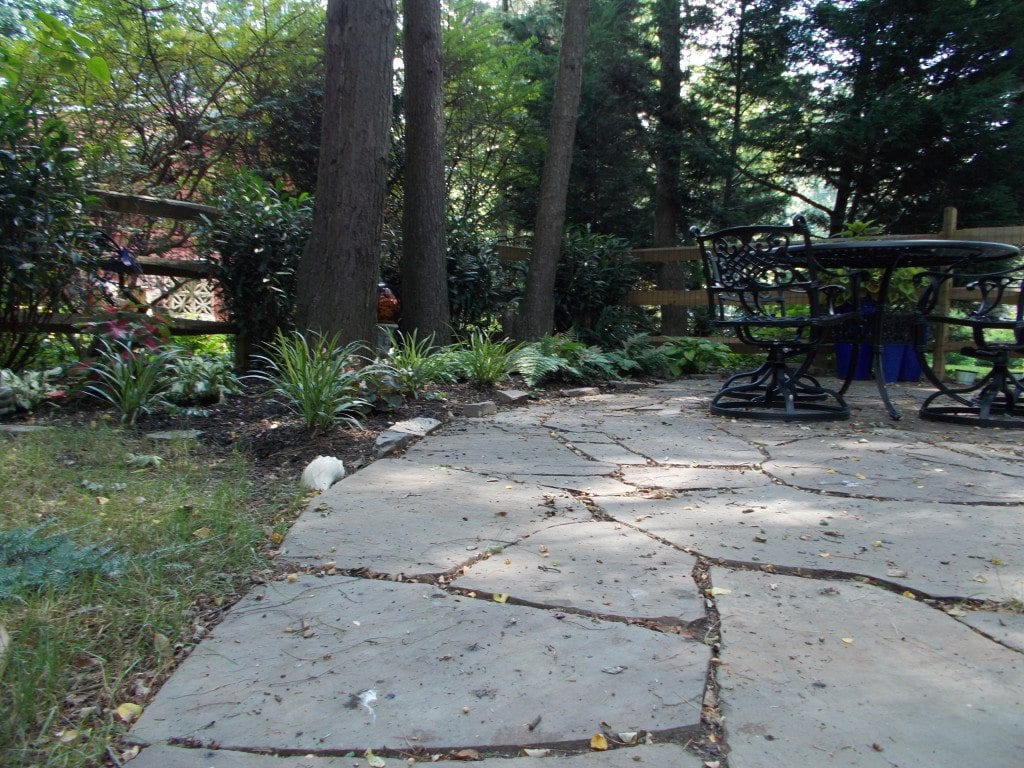
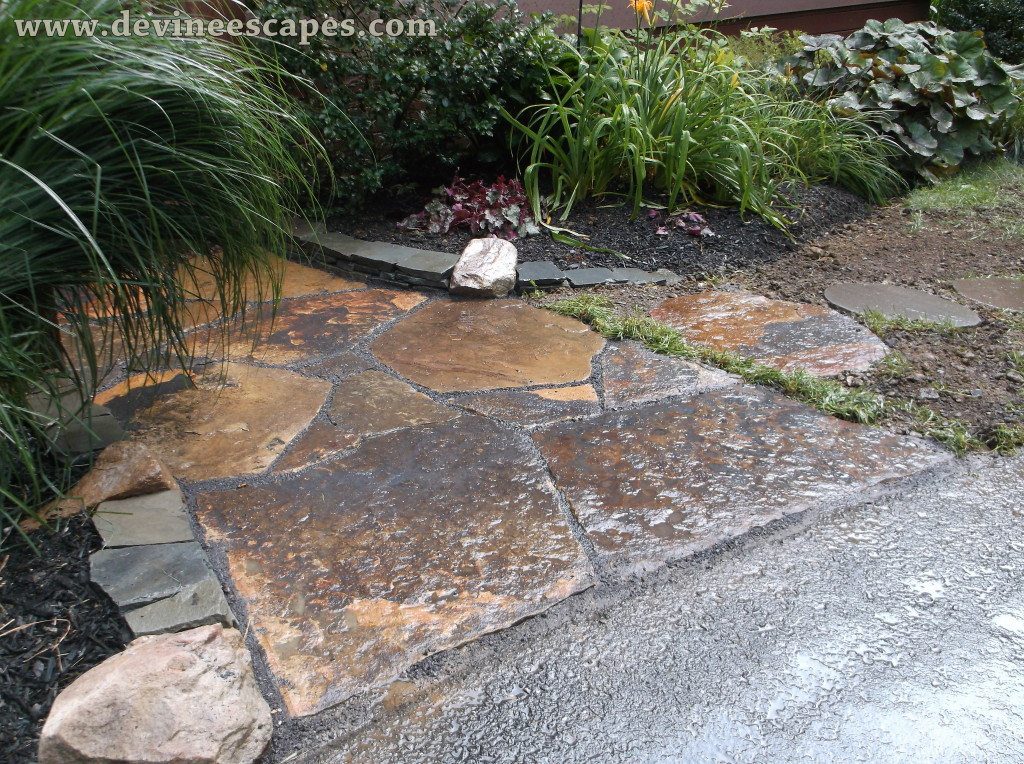
Sandstone. Pennsylvania bluestone, West Mountain flagstone, and many other common types of flagstone are sand stone. These are both widely available and are shipped all across the country.
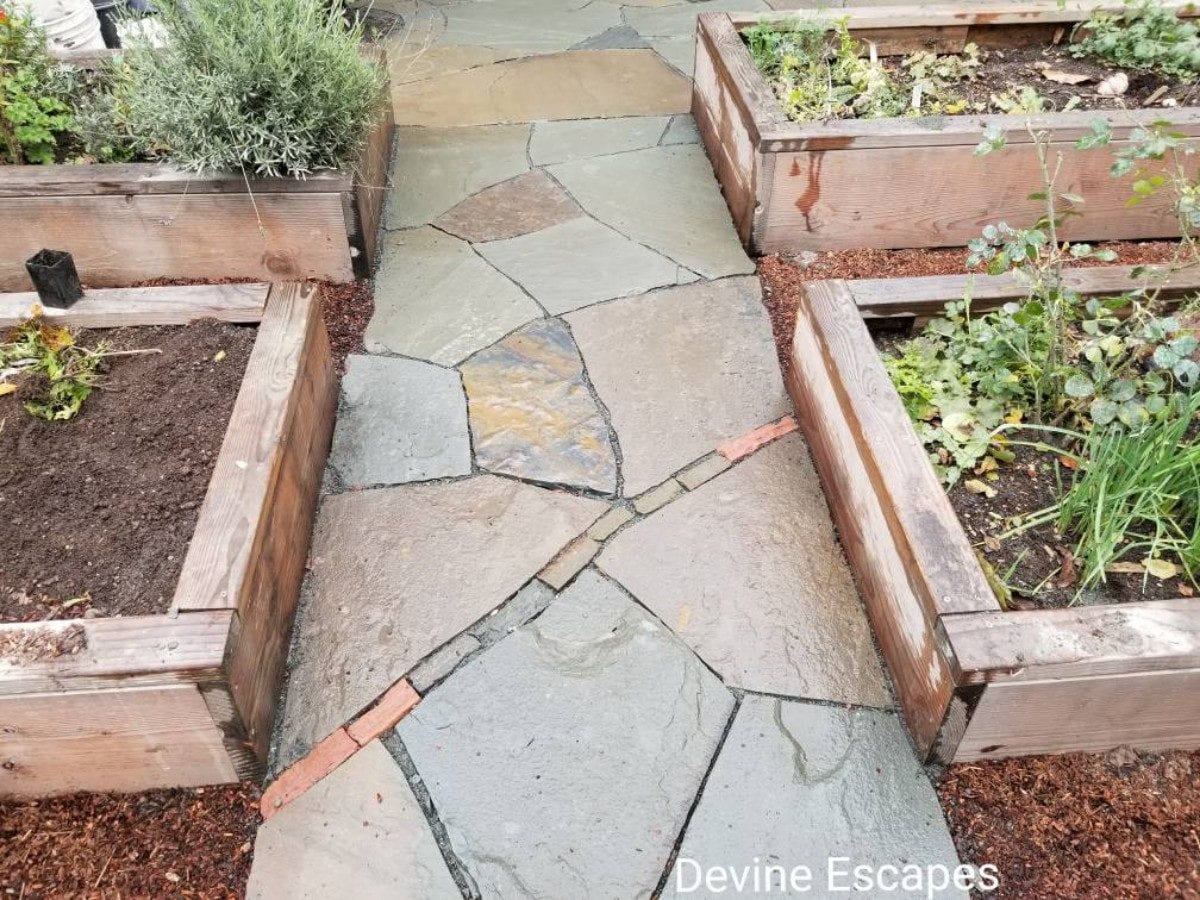
Arizona flagstone was used in the photo above–the pink accent pieces. Here, they are laid upright, like cobbles, rather than flagstones. Arizona flagstone can be rather pretty, so long as the work site, and client, can both stand the pink, peach, yellow cheerfulness of Arizona flagstone. Lightweight and porous, the flagstone from Arizona is not the most durable material, and I’d never use it in a northern climate. A few pieces, laid as cobblestones, in San Francisco, is alright though.
Ideally, you want a durable, quartzitic sandstone, like Pennsylvania Bluestone or something similar, inch and a half to two inches thick and breaking off into decent sized slabs, like 2 feet to 5 feet wide.
Related content: how to cut flagstone with a hammer
Slate
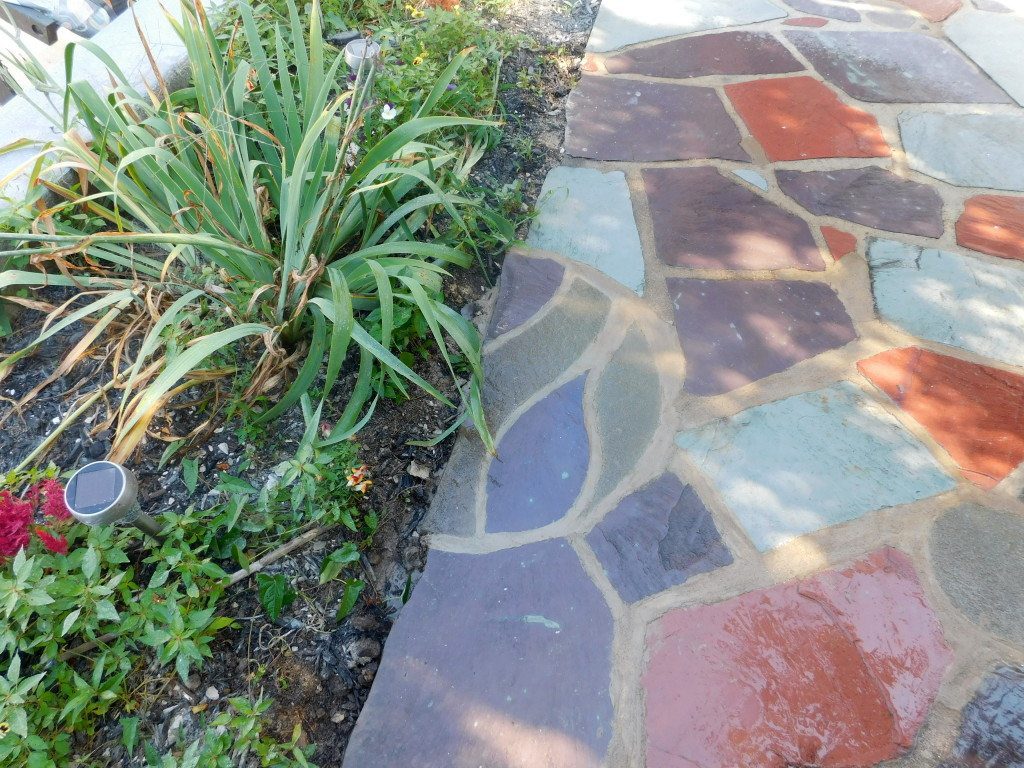
Slate was once commonly used as flagstone material. These days, I don’t see it too often, except for older stone patios, usually mortared. The slate flagstone that is available, is usually too thin for dry lay applications, and the pieces don’t have much for surface area either. This photo here is of a slate patio original built back in the 1980’s, repaired a few years ago.
Argilte
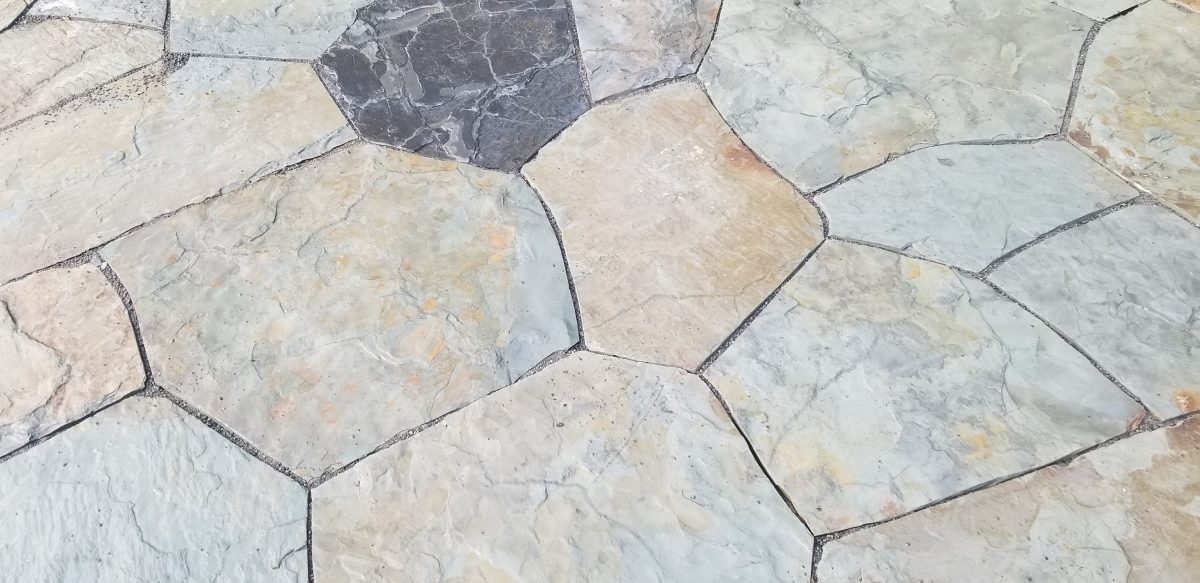
Okay, so this is a metamorphic stone. Was once shale (useless, crumbly, rock*) and in another few million years it might become slate. It’s a mud stone, started out as clay, hardened into shale, matured into Argilite. I do not recommend using this stone (for patios, or anything grade-level) anywhere that is subject to freeze-thaw as it the freezing and re-freezing of winter will cause bits of stone to flake off.
This is a very colorful material, with a deep color saturation that you just don’t get with any type of sandstone. Very dense, be warned this stone takes some work, will take at least twice as long to cut compared to most sand stones, and is all around considered a challenging stone to work with.
*Definition of a rock–a hard mineral stuff that is not considered useful for building or sculpting. An unemployed stone.
Quartzite
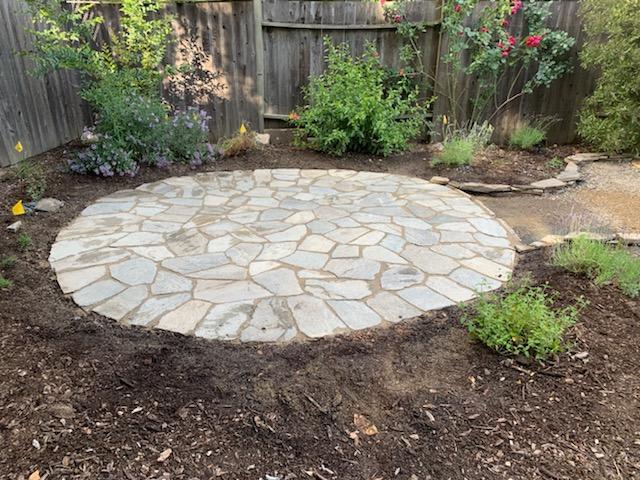
This material is not available in large enough sizes, generally speaking quartzite is not very useful in a dry-lay situation. As a professional I would not likely take on a new job, if it was using quartzite as a flagstone. Here, I was contacted by a homeowner who already had the stone and was going to use it to build their patio–which they did, making usage of my consultation services.
To me, when I saw this quartzite, I said, “that’s wall stone, not patio stone”. But I gave the homeowner an hour of my time explaining how the material can be used, and even stopped by for some hands-on help, bit of a site consultation, helped get them started. As you can see, the patio stones are not of a very large size. There is some concern about stability–the stones may not stay perfectly still underfoot, may wobble, or even kick up a bit. Stones on the edge are set length-in, as a measure against instability.
YES, the sandstone that I recommend is described as being “quartzitic”–it contains some quartz. Quartzite however is, IDK, “more quartzy”.
Geology might seem a bit confusing, at first….at least rocks/stone/crystals generally don’t move very fast, makes ’em easier to study.
So what type of stone should we use for our patio/walkway project?
Depends what’s available in your area–just make sure to use a material of appropriate size and durability. Pennsylvania bluestone is shipped all of the country–and for good reason as the material is imminently useful as flagstone and is rather versatile for use whenever you need a good stone. In your area, chances are you’ll be able to find Pennsylvania Bluestone, if you visit your local masonry supply house. Also, there is a good chance they’ll have something more local, which may or may not be suitable. I’ve seen lots of different types, beyond what I’ve listed here so far….may have to write up a part II–soon enough, soon enough.
Additional considerations, selecting quality flagstone
You gotta choose good, usable material.
- check for flatness
- check for spalling, or cracking
- sufficient thickness
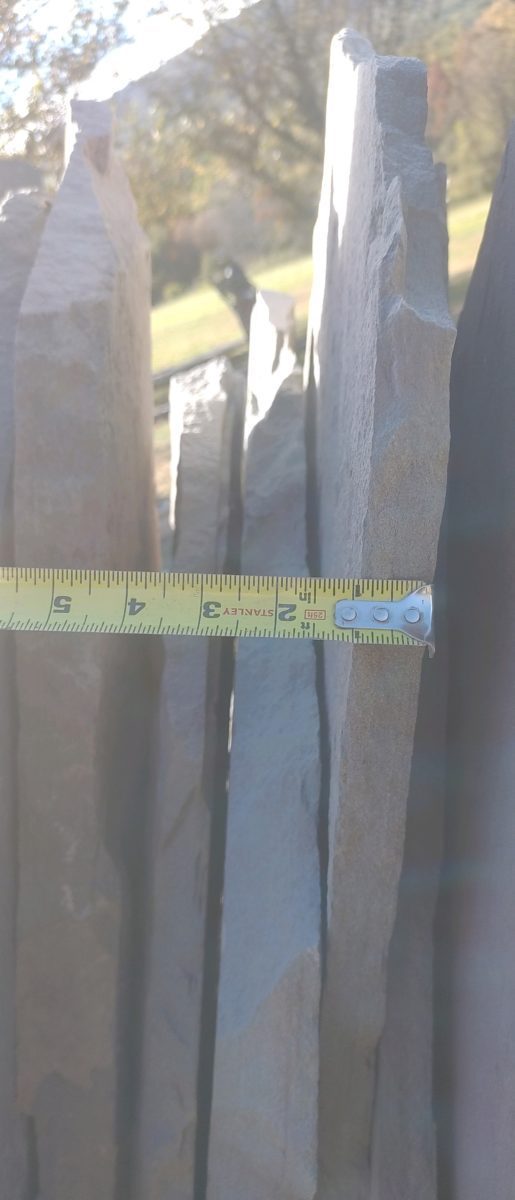
I sorted through tons of pallets…still, the best pallets I could find still contained a few stones that are too thin to be used as flagstone. Such is life.
Some stones are less flat than others. Time spent with a hammer and chisel can correct this.
(insert photo of lumpy flagstone)
Some stones show clear signs of cracking. Remember, more flagstones are sedimentary stone, built up in layers of sand over millions of years–and this layering is what makes the stone useable, what makes it breal off in nice flat, useable pieces. But then sometimes rfect inch and a half thick stone will have a crack in the middle–and when that stone splits, you’ll be stuck with two 3/4″ thick pieces–too thin for use in your patio.
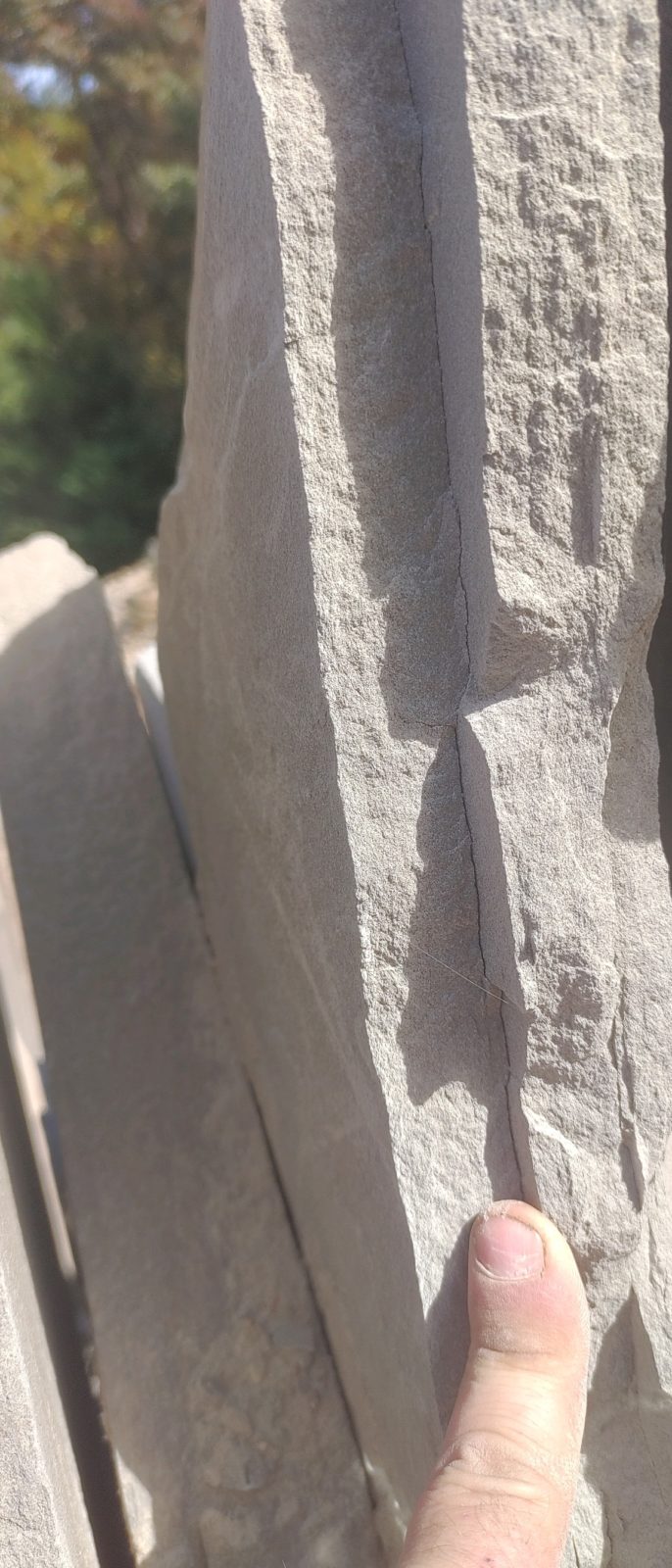
This photo shows a piece of flagstone that is spalling, or de-layering. Like a book, opening up. The stone is naturally built up in layers–but if you see the layers opening, it means the stone will peel up into two thin pieces, in time. This stone will not be used as flagging. Into the wall stone pile it goes!
If you need more help, send me your photos and tell me all about it:
DIY Flagstone and Hardscape help
My rates for DIY phone/email consultations are as follows:
$80.00 for a half hour consultation
$119.00 for a full hour
Monies are payable via zelle, venmo or paypal.
More stone work DIY and hardscape how-to:
- what to use for under flagstones, concrete, sand, gravel, or what?
- what to put between your flagstones, sand, mortar, polymeric sand…..or stone dust?
- replacing the cement between flagstones, re-pointing
- how to clean your flagstone patio
- DIY hardscape consultation services–professional guidance on “how to build your own flagstone patio”
Trackbacks/Pingbacks